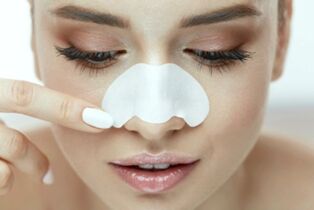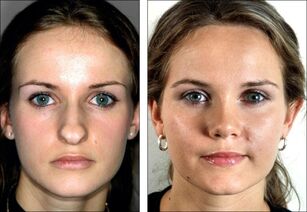Many have heard of classic surgery, but non-surgical rhinoplasty is a relatively new technique in medicine and of course there are many questions about it. This article will tell you about the nuances of conducting and rehabilitating non-surgical rhinoplasty. It will be especially useful for those who experience complexes for nasal imperfections, but are not ready for surgery.
What is this and how is it done?
Non-surgical correction of defects consists in the installation of special fillers or sutures, which are used to correct the shape of the nose and give symmetry.
This method is suitable for those who have minor defects that are not accompanied by breathing problems and a deflected septum or nasal bone.
This method cannot be called a complete alternative to surgery (with the exception of laser rhinoplasty), as some defects can only be corrected by classical rhinoplasty.

The differences between non-surgical and classical rhinoplasty are as follows:
- simplicity in performance, no long and painful period of rehabilitation (we described how rehabilitation with conventional rhinoplasty is done here);
- execution speed;
- affordable price;
- short duration of effect;
- Failed to fix serious issues.
It should be noted that this procedurecan be performed whenever the effect is weakened.
Types of plastics without operation
Non-surgical rhinoplasty can be of several types. How to make each of them and how long the result lasts will be described in detail below.
Injection
Nasal plastics with fillers - drugs for injections that are used as fillers to correct defects caused by lack of tissue.The procedure does not cause side effects,does not provoke puffiness and dissolves on its own within 1. 5 years.
The nasal area is treated with an antiseptic and then a filler is injected subcutaneously. The whole procedure takes about half an hour, after which the patient can go home.Fillers can be:
- biodegradable- produced on the basis of bio-substances - hyaluronic acid, collagen;
- biodegradable- synthetic substances - silicone and so on;
- autologous- the body's own adipose tissue.
Injectable rhinoplasty is also considered to be the administration of hormonal drugs. This procedure requires extreme care and precision, because if the correct dose is not followed, the situation can worsen.The effect after the procedure is quite long, but complications can occur in the form of tissue atrophy.
Laser
In this case, a laser is used instead of a plastic surgery scalpel, so the incisions are more gentle and the bleeding is eliminated due to the burning of the vessels.
The surgical approach to laser surgery is not much different from classical rhinoplasty.
With the help of a laser, the surgeon's task is simplified, it is possible not only to speed up the operation itself, but also to shorten the rehabilitation period. Before the operation, the patient should prepare, undergo tests and consult with specialists. With properly performed laser rhinoplasty, the result is maintained for a long time.
Threads
Many plastic surgeons do not consider this type of rhinoplasty to be effective, so it is not common. The threads are most often used to correct the shape of the tip or wings of the nose (read about the techniques of conventional rhinoplasty of the wings of the nose, its tip and other parts here). The specialist makes small punctures where the threads are inserted. The skin and tissues are fixed in position with artificial material. The effect lasts a long time.
Languages
Langette is a special device that looks like a plastic clip. It is designed to be worn for several hours a day so that changes in the shape of the cartilage tissue can be achieved. However, it will take several months to learn the effect. You can eliminate minor defects:
- returns symmetry to the nose;
- straighten a small hump;
- lift the tip of the nose (you will learn how to solve problems with the tip of the nose with the help of classic rhinoplasty of a special material);
- reduces the width of the wings.
Before and after photos
Then we offer you to get acquainted with the photos of patients before and after nose plastic surgery, which was performed without surgery.

Indications
Injectable rhinoplasty is performed in the following cases:
- hump on the back of the nose;
- flat upper back;
- nasal asymmetry;
- dips and valleys;
- drooping tip of nose;
- sharp corners of the nose;
- need for correction after surgical rhinoplasty.
Indications for laser rhinoplasty are:
- change in the length of the nose;
- nasal bridge too wide;
- unaesthetic spine of the nose;
- wide or narrow tip;
- nostrils too wide or too narrow;
- wing correction.
There are functional indications for this procedure:
- nasal injury with fracture of bone or cartilage;
- congenital curvature of the back of the nose, which disrupts the passage of air;
- cartilage base defect.
Contraindications
A number of contraindications:
- presence of cancer;
- predisposition to allergic reactions - possible allergy to fillers injected under the skin;
- period of pregnancy and lactation;
- early childhood - cartilage in children is not fully formed and premature correction can lead to worsening of the situation in the future;
- is not recommended to perform procedures during menstruation.
Why is this technique dangerous?
Despite the fact that non-surgical rhinoplasty has a very low effect on the condition of the body as a whole, it can lead to side effects:
- Improper placement of the filler under the skin can cause helium lumps to move to the side over time and the resulting shape will change.
- There is a risk of infection and infection.
- The swelling and bruising appear immediately after the procedure, but these effects usually disappear without treatment within a few days.
- It is impossible to change the shape of the nose immediately after a failed procedure, as the drugs administered are permanent and their separation begins only after a few months.
Other complications include:
- soreness;
- redness of the skin;
- embolic changes in the vessels;
- fibrous changes at the injection site;
- allergies;
- whitish accumulations in adjacent injection sites.
Complications can be short-term or long-term, if there is a constant deterioration in appearance or well-being, you should consult a specialist.
Most often, various types of complications occur after non-surgical rhinoplasty, when the procedure is performed by a low-skilled doctor or in non-specialized salons.
To prevent such inactive phenomena, you must take a responsible approach to the choice of clinic and doctor who will lead the procedure, and, if necessary, to properly prepare for the procedure. In addition, it is necessary to inform the doctor in advance about existing diseases, including chronic ones, as the choice of method will depend on this.
Here we talked about the consequences that patients can expect after classical rhinoplasty and how they can be avoided.
Rehabilitation

The peculiarity of non-surgical rhinoplasty is that it has a short rehabilitation period. On average, it will take 1-2 days until all the bruises and bruises disappear. Tissue swelling may persist for up to 5 days, and to reduce it more quickly, it is advisable to apply ice packs to the site of exposure in the first hours after the procedure - this will prevent the spread of swelling.
Summary table
| Retinoplasty type | Pros | ConsConsz / zxtr> |
| Fillers |
|
|
| Hormone injections |
|
|
| Laser |
|
|
| Threads |
|
|
| Langet |
|
|
Dissatisfaction with one's appearance often becomes the cause of a person's complexity, the development of depression and psychosis. But sometimes it is enough to just pull the tip of the nose a little so that life sparkles with bright colors and self-confidence appears.
But not all people, even very dissatisfied with their appearance, can afford classic rhinoplasty - some are afraid of the price, others are afraid of complications and unsuccessful operations, and some are afraid of a long period of rehabilitation. In this case, it makes sense to think of non-surgical rhinoplasty, which, although it cannot be a full-fledged alternative to surgery, can easily cope with some of the shortcomings.




















